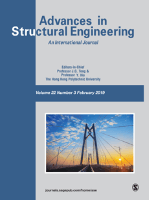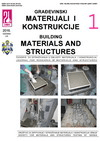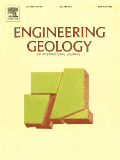
Bulletin of Earthquake Engineering
metrics 2024
Transforming knowledge into seismic resilience.
Introduction
The Bulletin of Earthquake Engineering is a premier journal published by Springer, dedicated to the field of earthquake engineering and its related disciplines. Established in 2003, this esteemed journal has evolved into a critical platform for disseminating cutting-edge research in Building and Construction, Civil and Structural Engineering, Geophysics, and Geotechnical Engineering and Engineering Geology, earning a distinguished position in the Q1 quartile across these categories. With an impressive ranking in Scopus, notably a rank of #8 in Earth and Planetary Sciences for Geophysics, the journal addresses urgent challenges in the mitigation of seismic risks and the enhancement of structural resilience. Researchers and practitioners benefit from a wealth of peer-reviewed articles, insights, and methodologies relevant to modern engineering practices aimed at improving safety and sustainability in earthquake-prone regions. The Bulletin of Earthquake Engineering embodies a commitment to advancing knowledge and practice in earthquake resilience, making it an invaluable resource for academics, industry professionals, and rising scholars alike.
Metrics 2024
 1.09
1.09 3.80
3.80 4.10
4.10 91
91Metrics History
Rank 2024
Scopus
IF (Web Of Science)
JCI (Web Of Science)
Quartile History
Similar Journals

STRUCTURAL ENGINEERING AND MECHANICS
Unveiling Insights into Structural Systems and MechanicsSTRUCTURAL ENGINEERING AND MECHANICS, a leading journal published by TECHNO-PRESS, stands at the forefront of research in the disciplines of civil, structural, and mechanical engineering. With an ISSN of 1225-4568 and an E-ISSN of 1598-6217, this South Korea-based journal has been a significant contributor to the academic community since its inception in 1994, and it continues to disseminate vital research through 2024 and beyond. Achieving a Q3 ranking in key categories such as Building and Construction, Civil and Structural Engineering, Mechanical Engineering, and Mechanics of Materials, the journal is recognized for its high standard of academic rigour and relevance in contemporary engineering challenges. Although not Open Access, it offers robust access options for institutions and professionals seeking to advance their understanding of structural systems and mechanics. Researchers, students, and practitioners in these fields will find invaluable insights and innovative studies that push the boundaries of knowledge, making this journal an essential resource for anyone invested in engineering advancements.

ADVANCES IN STRUCTURAL ENGINEERING
Transforming Ideas into Engineering ExcellenceADVANCES IN STRUCTURAL ENGINEERING, published by SAGE PUBLICATIONS INC, is a leading journal dedicated to the advancement of knowledge in the fields of Building and Construction, as well as Civil and Structural Engineering. With a solid impact factor and a commendable Scopus ranking (Rank #60 in Building and Construction, Rank #105 in Civil and Structural Engineering), this journal stands at the forefront of academic research, providing a platform for high-quality articles that contribute significantly to the discipline. Covering a range of topics from innovative construction techniques to sustainable engineering practices, the journal aims to foster collaborative dialogue among researchers, industry professionals, and students alike. As of 2023, it boasts impressive category quartiles, ranking Q1 in Building and Construction and Q2 in Civil and Structural Engineering. ADVANCES IN STRUCTURAL ENGINEERING is a vital resource for those looking to stay abreast of emerging trends and groundbreaking developments in structural engineering, promoting an environment of continuous learning and application of best practices. With a convergence of research from 1999 to 2024, the journal not only emphasizes theoretical frameworks but also bridges the gap between academia and practical application in engineering projects.

Earthquake Engineering and Engineering Vibration
Pioneering solutions for a quake-resilient infrastructure.Earthquake Engineering and Engineering Vibration, published by Springer, is a leading international journal dedicated to the field of earthquake engineering, structural dynamics, and the associated vibrational research integral to understanding and mitigating seismic risks. With its print ISSN 1671-3664 and E-ISSN 1993-503X, the journal operates from its headquarters in New York, USA. The journal has achieved a commendable Q2 category ranking across multiple engineering disciplines, reflecting its importance to the building and construction, civil and structural engineering, geophysics, geotechnical engineering, and mechanical engineering fields. The journal serves as a vital platform for researchers, practitioners, and students to disseminate their findings, share innovative methodologies, and contribute to advancements in earthquake resilience and engineering practices. Earthquake Engineering and Engineering Vibration is committed to fostering open dialogue and collaboration within the global research community, ensuring that its contributions are both impactful and relevant to contemporary challenges in engineering and environmental safety.

Gradevnski Materijiali I Konstrukcije-Building Materials and Structures
Shaping the future of construction through open-access research.Gradevnski Materijiali I Konstrukcije - Building Materials and Structures is a premier open-access journal dedicated to advancing the field of construction materials and structural engineering. Published by SOC MATERIALS & STRUCTURES TESTING SERBIA, this journal provides a platform for researchers, professionals, and students to share their innovative findings and developments in building materials. With a commitment to open-access since 2012, it fosters unrestricted availability of research for a wider audience, encouraging collaboration and knowledge dissemination. The journal features a diverse range of topics, including material testing, structural integrity, and sustainable construction practices, making it a vital resource for those engaged in the design and analysis of structural components. By fostering the advancement of research and practice in this crucial sector, Gradevnski Materijiali I Konstrukcije plays an essential role in shaping the future of construction and material science.

CIVIL ENGINEERING
Empowering Engineers with Cutting-Edge InsightsCIVIL ENGINEERING is a prominent journal published by the American Society of Civil Engineers (ASCE), dedicated to advancing the field of civil engineering since its inception in 1969. With an ISSN of 0885-7024, this journal spans a wide range of topics, including civil and structural engineering, geotechnical engineering, and materials science, reflecting its comprehensive coverage of the discipline. Although currently categorized in the Q4 quartile for several fields, the journal provides a platform for researchers, professionals, and students to present innovative solutions and research findings that push the boundaries of civil engineering practices. While it does not offer open-access options, its accessibility through institutional subscriptions ensures that critical research remains within reach for those intent on furthering their understanding and applications in the field. Conference proceeding articles, case studies, and theoretical papers contribute to its mission of fostering communication and knowledge exchange among civil engineering practitioners and scholars. The journal's commitment to quality and relevance in today's evolving engineering landscape makes it an essential resource for informed decision-making and professional development.

Turkish Journal of Civil Engineering
Building Bridges Between Research and PracticeWelcome to the Turkish Journal of Civil Engineering, a pioneering publication under the auspices of the TURKISH CHAMBER OF CIVIL ENGINEERS, dedicated to advancing the field of civil engineering and construction. With a focus on cutting-edge research and innovative practices, this journal seeks to provide a platform for scholars, professionals, and students to share their findings and insights within the sphere of civil and structural engineering. The journal is committed to open access, ensuring that research is readily available to a global audience. As it embarks on its journey from 2023 to 2024, it aims to enhance its reputation as a vital resource within the academic community, currently ranking in the 40th percentile for Building and Construction Engineering and 32nd for Civil and Structural Engineering in Scopus. We encourage contributions that push the boundaries of engineering knowledge, fostering collaboration and progress in this essential field.

EARTHQUAKE SPECTRA
Transforming earthquake science into practical solutions.EARTHQUAKE SPECTRA, published by SAGE PUBLICATIONS INC, is a premier journal dedicated to the field of geophysics, geotechnical engineering, and engineering geology, with a specific focus on seismic phenomena. Issued both in print (ISSN: 8755-2930) and electronically (E-ISSN: 1944-8201), the journal has maintained its position as a leading source of high-quality research since its inception in 1984. Recognized in the 2023 Category Quartiles as Q1 in both geophysics and geotechnical engineering, it is highly regarded in the academic community, ranking 11 out of 165 in its field, placing it in the 93rd percentile of Earth and Planetary Sciences, and 30 out of 229 for geotechnical engineering with an 87th percentile standing. With a commitment to advancing knowledge and practice in earthquake engineering, EARTHQUAKE SPECTRA publishes original research, case studies, and critical reviews that inform the design and construction practices related to seismic events. Although it does not currently offer open access, the journal's impact on the discipline remains significant, making it an essential resource for researchers, professionals, and students dedicated to understanding and mitigating the effects of earthquakes.

ENGINEERING GEOLOGY
Driving Innovation in Geological Hazard EvaluationENGINEERING GEOLOGY, published by Elsevier, is a leading journal in the fields of Geology and Geotechnical Engineering, recognized by its prestigious Q1 ranking in both categories for 2023. With a deep focus on the application of geological principles to engineering practices, this journal plays a vital role in advancing knowledge and methodologies that enhance infrastructure development and environmental sustainability. Operating since 1965, the journal disseminates high-quality research, offering insights that foster innovation in geotechnical assessments and geological hazard evaluation. Researchers and professionals benefit from its rigorous peer-review process and impactful studies, bolstered by a strong Scopus ranking - #4 in Geology and #3 in Geotechnical Engineering, both placing it in the top 2% of its field. Although there is no Open Access option available, the journal facilitates significant academic discourse, making it an essential resource for anyone involved in the intersection of geology and engineering.

Revista Ingenieria de Construccion
Innovating Building Practices for a Sustainable FutureRevista Ingenieria de Construccion is a prominent open-access journal dedicated to advancing knowledge and practice in the fields of building and construction engineering, as well as civil and structural engineering. Published by the Pontificia Universidad Católica de Chile, specifically the Department of Engineering and Construction Management, this journal has been providing free access to quality research outputs since 1986, ensuring that vital information is available to both practitioners and academics globally. With its current placement in the Q4 category of both the Building and Construction and Civil and Structural Engineering quartiles, it serves as a platform for innovative studies and critical discussions, positioning itself strategically within the academic landscape. The journal is indexed in Scopus, ranking #157 in Building and Construction and #291 in Civil and Structural Engineering, reflecting the growing impact and relevance of its contributions. Researchers, professionals, and students are encouraged to engage with the rigorous and diverse content published within its pages, fostering a vibrant academic and practical discourse.

Journal of Structural Integrity and Maintenance
Advancing the Future of Structural Integrity and MaintenanceThe Journal of Structural Integrity and Maintenance, published by Taylor & Francis Ltd, serves as a prestigious platform dedicated to the advancement of knowledge in the fields of structural integrity, civil engineering, and materials science. With an ISSN of 2470-5314 and an E-ISSN of 2470-5322, this journal is uniquely positioned to address the critical challenges faced by researchers and professionals in building and construction, mechanical engineering, and related domains. Since its inception in 2016, this journal has been consistently recognized for its quality, currently holding a Q2 rank across several disciplines, including Building and Construction and Civil and Structural Engineering in 2023. The journal aims to publish high-quality research that contributes to the understanding and maintenance of structural integrity, fostering innovations that promote safety, efficiency, and sustainability in engineering practices. Researchers and students alike are encouraged to engage with this rich repository of knowledge, which plays a vital role in shaping future advancements in structural engineering and materials science.